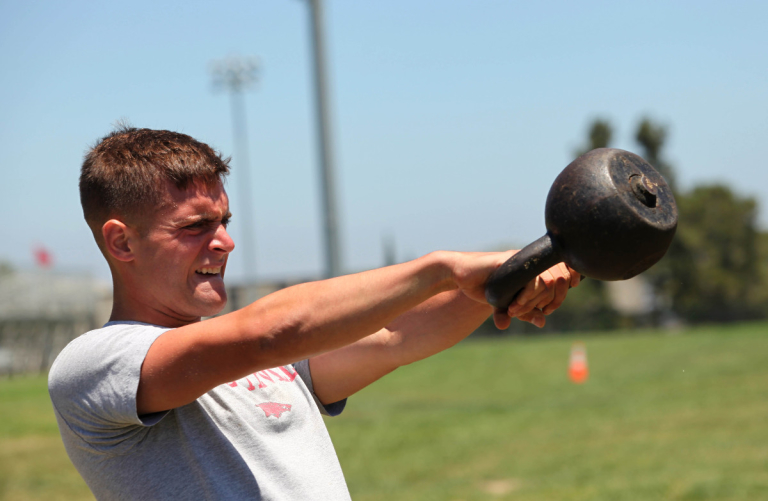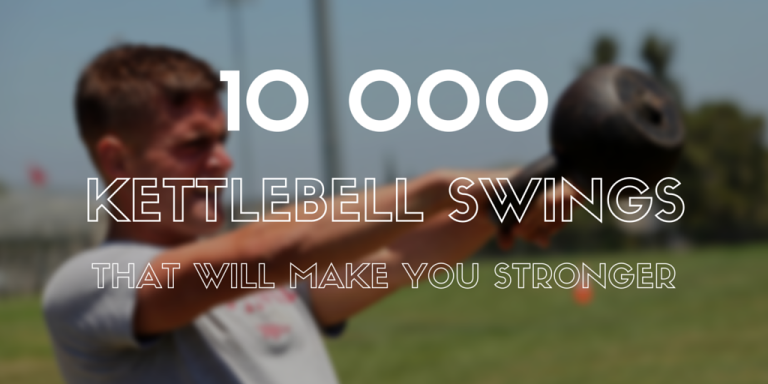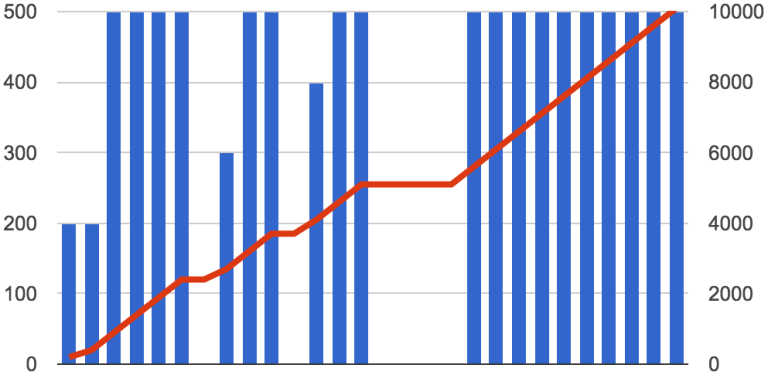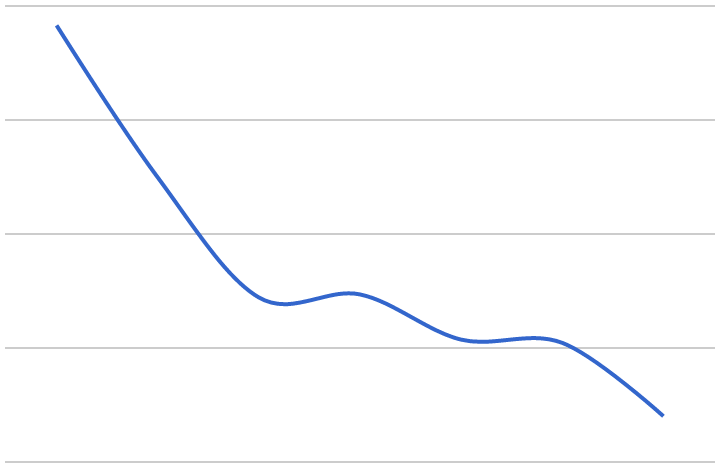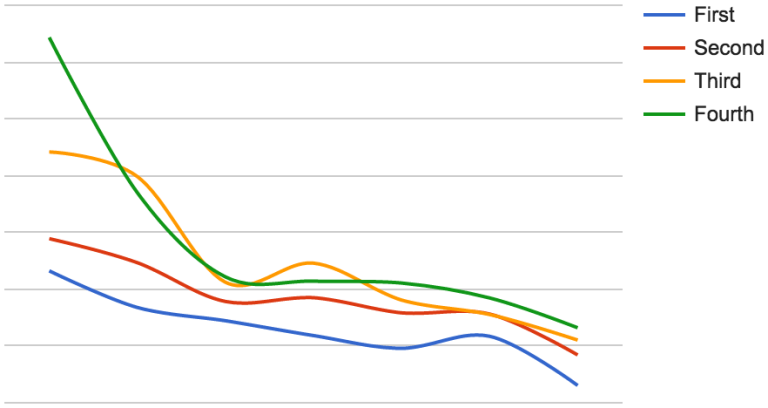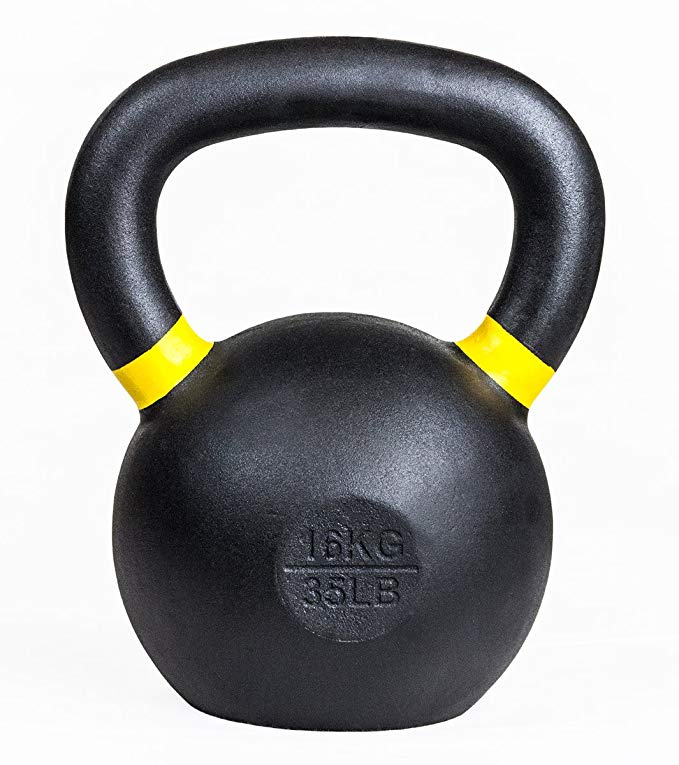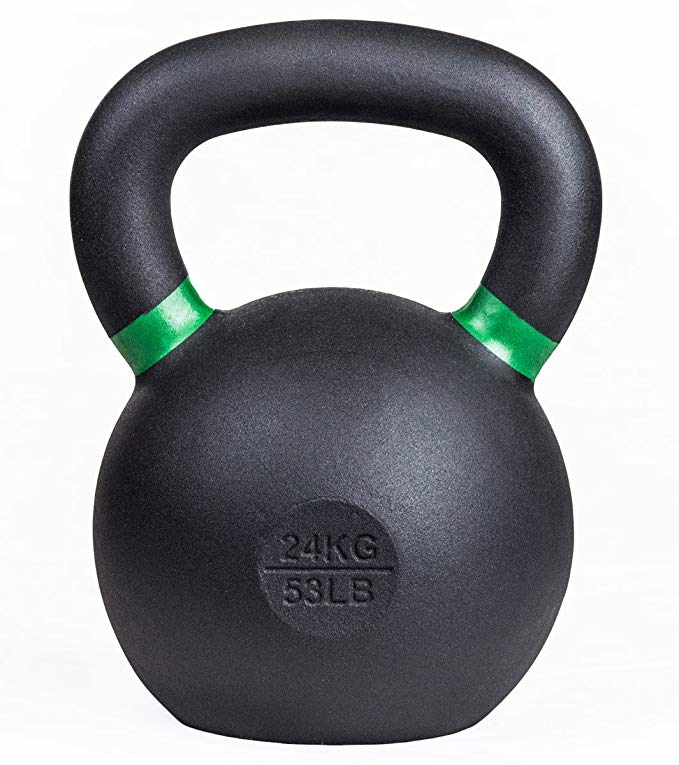I swung a kettlebell ten thousand times during the course of a few weeks. It’s awful, I wanted to quit, and here’s why I’d do it again.
After having done more than three months of strength training with the Starting Strength program, I was ready to mix things up a bit. Because I had planned to run Tough Viking a month later I also wanted to improve my conditioning, while keeping the strength I’d worked so hard for.
There are so many training programs out there but I’ve always been curious about using kettlebells as my main strength equipment and so when I found The 10,000 Kettlebell Swings Challenge I was hooked.
Yes, ten fucking thousand kettlebell swings.
The 10,000 Kettlebell Swings Challenge is the brainchild of coach Dan John, who wrote about it for T-nation. He later expanded on the article in a forum post and I recommend checking both out.
Dan ran this himself, together with 18 other coaches and athletes and these were their results:
- Everyone got leaner, dropping a waist size or two, in 20 workouts.
- Every coach or athlete made visual muscular improvements in their physiques, adding lean body mass.
- Every lifter increased his grip strength and greatly increased work capacity and athletic conditioning. They could all train longer and harder when they went back to their normal training programs.
- After the program, every lifter saw a noted improvement in his core lifts. PR’s fell like dominos. Full-body strength and power shot through the roof.
- Abs were more visible. Glute strength was tremendously better. The abs and glutes “discovered” how to work again, leading to athletic improvements in sport and in the weight room.
Sounds pretty damn good to me! I’ll share my own results further down.
*NB! Your form will deteriorate when doing this many repetitions. Bad form increases the risk of injury and so if your’s not great yet, I wouldn’t do this program just yet. Start practicing the kettlebell swing properly and make sure you can consistently perform it with good form.*
The program #
It’s a very simple program and therein lies its beauty. Just keep swinging until you’re done.
Men are recommended to use a 24 kg (54 lbs) kettlebell and women 16 kg (36 lbs). These are only recommendations and you should pick a kettlebell that’s heavy enough for you. Dan says:
This is a stand-alone program. If you feel you’re able to do a second workout on the same day, then you are ‘underbelled’ – you’re either not going heavy enough or not training with maximal effort.
Each day you do 500 kettlebell swings, broken down into five rounds of 100. These rounds are “clustered” in groups of 10, 15, 25, and 50 swings and you rest a little between each group.
You’ll also pick one strength exercise per day, which you’ll do after finishing each group, in reps of 1, 2, and 3. Some example exercises are: press, dip, squat, chin-up.
It sounds more complicated than it is. Here’s the template:
- 10 swings, 1 squat
- Rest
- 15 swings, 2 squats
- Rest
- 25 swings, 3 squats
- Rest
- 50 swings
That’s 100 swings. After the final 50, you rest again, before tackling the next round. Repeat five times and you’ll have done 500 swings. Do this two days in a row and then rest one before going again.
Four weeks later – 10,000 kettlebell swings completed!
Or you can do like me: train Monday and Tuesday, rest Wednesday, train Thursday and Friday, rest Saturday and Sunday. Repeat for five weeks and you’ll have done 10,000 swings.
Variations #
Because the program’s so simple and people always think they can make it better, many variations have popped up. Dan John is pretty clear what he thinks of this:
If you change it, fine, but then it’s not the program… I walked into the Sistine Chapel and saw Michelangelo on the scaffolds. I yelled up, “more blue”. That’s how I feel when I see people look at a program and immediately “make it better”.
With that said, here are some variations you might want to consider.
Different clustering #
The base is 10, 15, 25, and 50 swings but Dan has tried this with 15, 35, 15, 35 as well as using heavier kettlebells for 10, 15, 10, 15, 10, 15, 10, 15 swings. I’d like to try the latter one sometime.
Others have tried using a “breathing ladder”, where you swing the kettlebell once, put it down and take one deep breath, swing it twice, two breaths, etc, etc. Do this up until ten and then back down to one again – that’s 100 swings.
Timed resting #
The original program didn’t prescribe any rest time. I found this weird because rest can affect your finish time a lot and that’s the main progression variable throughout this program.
I tried some different setups but found it best to rest 30 seconds after the group of 10, 60 seconds after the group of 15, 90 seconds after the group of 25, and 300 seconds between rounds.
In the beginning, I couldn’t do fifty swings in a row, without putting the kettlebell down to rest. So this was my initial focus. Once I could go unbroken through the rounds I started shortening the rest time and in the end, these were my rounds:
- 10 swings, 1 rep strength
- 15 seconds rest
- 15 swings, 2 reps strength
- 30 seconds rest
- 25 swings, 3 reps strength
- 45 seconds rest
- 50 swings
My experience #
It took me longer than planned to complete the 10,000 Kettlebell Swings Challenge. Normally you’ll do it in four or five weeks, depending on whether you rest two days in a row or keep a rolling schedule with only ever one rest day. It took me seven weeks.
As you can see above I started out doing two days of only 200 swings. Coming from no conditioning at all for half a year, it felt like a wise choice. In hindsight, I should have just kept grinding and not caring if the initial workouts took long.
Later I skipped two Thursdays and didn’t do the full five hundred on the following Friday. I was feeling beat up. Again, I should have kept at it and ground it out.
The middle is me going on vacation, with no access to kettlebells.
While on vacation I put together some charts for my progress – the one above – and was surprised to see how much I sucked. I really didn’t feel like I’d skipped out of that many workouts but the numbers told the story clearly.
When I came back home, motivated by this chart, I kept swinging until I hit 10,000.
My results #
I really enjoyed this program and saw some great benefits from it too!
Running the Tough Viking obstacle race was no problem, despite me not having run a single meter, nor done any cardio whatsoever, for half a year. I was quite surprised by how well and quickly this kettlebell challenge improved my conditioning.
My grip became stronger and my forearms grew too. While I haven’t tried it yet, I know this will benefit my deadlift, pull-ups, and anything that requires a good, steady grip.
Further, I lost about three kilos of fat during this, without losing hardly any muscle. My diet was pretty good though and so it’s hard to know which factors deserve attribution.
Not only your muscles adapt to stress, but your skin too. This was definitely noticeable, as my hands would easily rip in the beginning and now my palms are thick leather. My girlfriend doesn’t get massage anymore – she gets exfoliate treatment.
I learned the power of accountability and taking regular inventory. In the future, I’ll definitely do a weekly review of my planned training vs my actual training.
My technique improved manyfold. You’re swinging a heavy weight and you’re tired, so you’ll be forced to find the optimal form and I feel like I did. I now also know how to modify the swings on the fly if my forearms get tired, my glutes start tiring, quads are complaining, etc.
Finally, this challenge wasn’t only physical but mental as well. I wanted to quit many times, kept coming up with excuses, but in the end, I learned to stop second-guessing and just grind.
My improvement #
I went from doing the five hundred swings in over an hour to 38 minutes in the end, including the three minutes rest between rounds. An improvement of over 30% in just a couple of weeks!
What’s interesting though is where the bulk of that improvement happened. I started out with a decent first round, okay second round, and then deteriorating from there to an awful fourth round.
I gassed out early and this program fixed that for me. Broken down into individual rounds:
My tips #
If you’re thinking about doing the 10,000 Kettlebell Swings Challenge (and I think you should!) then here’s my advice to make it a better experience and get the most out of it.
Hold fast #
Most likely your grip will suffer. Remember that when it hurts, you’re growing stronger. Push through it and hold on to the kettlebell for as long as you possibly can. You will get stronger.
Keep pushing #
After the initial shock, you’ll find it easier and easier. That’s not what you want though – you want to make it as tough and uncomfortable as you can possibly endure.
Try to always beat your previous time, increase the weight of the kettlebell, vary the strength exercises to make them harder. Keep pushing your limits and your body will reward you.
Grip well #
Don’t grip with the middle of your hand, but put the kettlebell handle just below where the fingers connect to your hand and then grip it. You want to avoid having the weight fold that skin area as it’ll inevitably drop closer to your fingers during the swings.
This will help a lot in avoiding ripped hands.
Don’t bother with gloves – you’re not playing golf. If your hand rips though, I suggest getting some cheap sports tape and covering it up so you can continue swinging while it heals.
One at a time #
Ten thousand swings is a frightening number. Don’t think about it – break it down into five hundred per day, hundred per round, and ten per group. Then do one swing, and another, and another. Focus only on what’s immediately in front of you and you’ll be fine.
If you feel like giving up, at least finish the next group. Then maybe the next and so on.
Visualize your progress #
Ever session is the same, which makes it hard to see any variation and you might mistake that for a lack of progress. I use spreadsheets to visualize getting closer to the end but if you’re less of a nerd you could also draw twenty boxes on a paper and cross one out each time you complete a workout.
Learn the swing #
You’ll be swinging that kettlebell ten thousand times, so you better learn proper technique.
Hinge at your hips, because it’s not a squat. Keep your chest up and back straight. Explode out of the bottom position, so you don’t have to pull the kettlebell with your arms.
American swings take the kettlebell to overhead, while Russian swings stop with your arms at about a 60˚ angle. Personally, I prefer a hybrid where I stop at just over eye level.
Get a good bell #
Finally, if you’re going to do this challenge, I recommend you get a proper kettlebell. It’s a shitload of reps, so don’t punish your body further with a bad quality bell.
Check out these kettlebells by Physical!
Some of these links are “affiliate links”. If you click and buy through them we get a small commission – at no extra cost of yours. It’s an easy and free way to support Athlegan! Of course, we only recommend services and products that we truly like and use ourselves.
